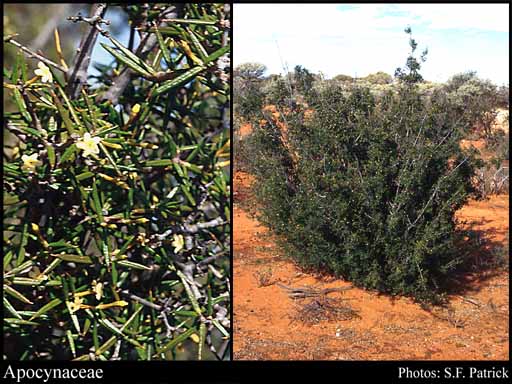- Reference
- Gen.Pl. [Jussieu] 143-144 (1763)
- Name Status
- Current

Scientific Description
Common name. Dogbane Family.
Habit and leaf form. Trees (a few, e.g. in Tabernaemontana, Dyera), or shrubs, or lianas (mostly), or herbs to herbaceous climbers (e.g. Vinca); evergreen; laticiferous. Climbing (usually), or self supporting (sometimes); mostly stem twiners (with hooks). Twining anticlockwise (Dipladenia). Leaves alternate, or opposite, or whorled; when whorled 3 per whorl; simple. Leaf blades entire; pinnately veined. Leaves with stipules (rarely), or without stipules. Stipules when present, interpetiolar (small). Domatia recorded (in 15 genera); represented by pits, or pockets, or hair tufts. Stem anatomy. Nodes unilacunar. Secondary thickening developing from a conventional cambial ring, or anomalous; from a single cambial ring.
Reproductive type, pollination. Fertile flowers hermaphrodite. Unisexual flowers absent. Plants hermaphrodite. Pollination mechanism conspicuously specialized (usually with a highly modified stylar head and specialised anthers).
Inflorescence and flower features. Flowers aggregated in ‘inflorescences’. The terminal inflorescence unit usually a panicle. Flowers bracteate; bracteolate; regular; usually 4–5 merous; cyclic; tetracyclic. Hypogynous disk usually present. Perianth with distinct calyx and corolla; 10; 2 -whorled; isomerous. Calyx 5; 1 -whorled; gamosepalous; imbricate (quincuncial); regular; with the median member posterior. Corolla 5; 1 -whorled; appendiculate (often, in the form of scales in the throat); gamopetalous; contorted (usually), or valvate (rarely); funnel-shaped, or hypocrateriform; regular; white, or yellow, or red, or pink, or purple, or blue. Androecium 5. Androecial members adnate (epipetalous); united with the gynoecium, or free of the gynoecium; free of one another, or coherent; 1 -whorled. Androecium exclusively of fertile stamens. Stamens 5; isomerous with the perianth; oppositisepalous; all alternating with the corolla members. Anthers cohering, or connivent (often sagittate, empty below and prolonged into spines, sometimes united with the stylar head), or separate from one another; adnate; tetrasporangiate; appendaged (by prolongation of the connective), or unappendaged. Gynoecium 2 carpelled, or 3–5 carpelled (Pleiocarpa). The pistil 1 celled, or 2 celled. Gynoecium syncarpous (but sometimes the carpels united only by their styles); synstylovarious to eu-syncarpous, or synstylous (Plumerioideae); superior, or partly inferior. Ovary unilocular, or plurilocular; 1 locular, or 2 locular (or the ovaries free, usually two but 3–5 in PLeiocarpa). Gynoecium transverse. Styles 1. Stigmas 1 (the head usually massively thickened, contracted in the middle, with a ring, a ring of hairs or a membrane below); wet type, or dry type; papillate, or non-papillate; Group II type, Group III type, and Group IV type. Placentation when unilocular, the two placentas parietal; axile, or apical (ventral in the free ‘locules’ of Pleiocarpa). Ovules 2 per locule, or 4 per locule, or 6 per locule, or 25–50 per locule (‘many’); pendulous; anatropous.
Fruit and seed features. Fruit fleshy, or non-fleshy; dehiscent, or indehiscent, or a schizocarp. Mericarps when schizocarpic comprising follicles. Fruit a capsule, or a berry. Seeds copiously to scantily endospermic, or non-endospermic. Endosperm oily. Seeds usually flat; conspicuously hairy (comose, in the Apocynoideae), or not conspicuously hairy (Plumerioideae). Cotyledons 2. Embryo achlorophyllous (10/12); straight. Seedling. Germination phanerocotylar, or cryptocotylar.
Physiology, biochemistry. Aluminium accumulation demonstrated (a few genera only), or not found (mostly). Photosynthetic pathway: C3 and CAM.
Geography, cytology, number of species. World distribution: widespread. X = 8–12(+). 1500 species.
Economic uses, etc. Many past, inferior commercial sources of rubber (e.g. Carpodinus, Landolphia, Mascarenhasia), numerous showy ornamentals, several sources of drugs and alkaloids, edible fruit (‘Natal plum’) from Carissa carandas.